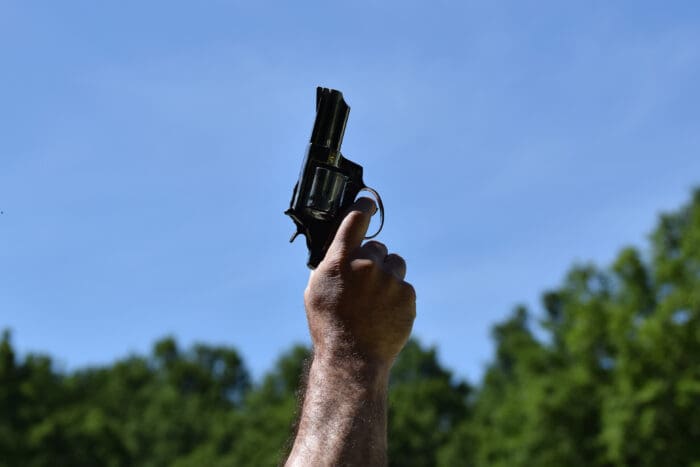Maybe it’s because the current president, one Joe Biden, has advocated “taking the ol’ double barrel out and firing it in the air to scare away” intruders or maybe it’s because they simply don’t fully grasp the ramifications of sending unaimed shots into the air or other directions, but the liberal judges sitting on the Ohio Supreme Court recently ruled in favor of a gun owner, saying “firing warning shots can be considered ‘self-defense.’”
WEWS News reported on last week’s ruling that was made possible by the liberal justices on the state’s Supreme Court and provides what is technically a win, albeit a little bit of a confusing one, for gun rights advocates. The ruling was actually decided by three liberal justices and one conservative one on the court.
Here’s the background on the case from WEWS:
During an altercation at a gas station in 2021, Tyler Wilson fired a warning shot at Billy Reffett’s car, claiming he was acting in self-defense. Wilson claims Reffertt threatened him and pulled a gun on him.
But a Clark County judge said Wilson wasn’t protecting himself because he didn’t aim the gun at the supposed assailant, so the judge didn’t allow him to argue self-defense in court, seemingly saying that if Wilson was really scared for his life, he should have shot Reffertt. His defense attorney didn’t fight back for him.
Wilson was acquitted of attempted murder but was found guilty of felonious assault. He was sentenced to more than a decade in prison.
In an appeal by the Second District Court of Appeals, the justices agreed with the lower court ruling 2-1.
The Second District Court of Appeals agreed with the lower court 2-1, denying his request to overturn. He argued that his attorney was ineffective.
“If you’re in fear for your life or trying to protect yourself or other loved ones from harm, that a warning shot can be an element of self-defense,” Rob Sexton with the Buckeye Firearm’s Association told WEWS.
Warning shots have traditionally been looked upon by the law in virtually every state as a no-no, the reasoning being several-fold. First, to fire your gun in self-defense as the result of any attack, altercation or potentially violent event, both state and federal law have traditionally said a person must be in fear of imminent harm or death, in which case, the shots fired should be directly at stopping that imminent harm or death by shooting that threat. If the level of imminent harm or death are not met, then shots shouldn’t be fired goes the legal reasoning.
Tactically, warning shots are also a bad idea on a couple of fronts. Shooting in a direction away from the threat, such as in the air, to the left or the right or even toward the ground, can lead to bullets ricocheting or flying in directions that can harm innocent people, which will also put you in sometimes major legal jeopardy. They can also escalate a situation by creating the sound of shots that lead to other people shooting, because they are not sure exactly who the shots are aimed at or why. And, quite simply, warning shots can use up precious ammo a person has loaded in their gun and available to defend themselves should the warning shots fail and the attack continue or escalate.
That’s a lot to consider.
The surprising aspect of the Ohio Supreme Court’s decision, which was split 4-3, is that it was the liberal judges who pushed that one across the goal line.
Sexton told WEWS he was “surprised” at the ruling, not so much because of the ruling itself, but because of who supported it in the court.
“Knowing that the high court has agreed with that, even those that you would typically assume would not be necessarily pro-Second Amendment, makes a stronger case for future self-defense claims,” he told the station. The court itself is reported to be a conservative-leaning court, but most of the conservatives on the court, except for one, went with the traditional legal view of warning shots.
Case Western Reserve University law professor Jonathan Entin, who was interviewed for the story told WEWS the case is not so much about guns as it is “more a question of how easily should it be to assert self-defense.” He explained the court didn’t technically say this particular defendant “acted in self-defense” only that “the jury should have been allowed to consider” if he had acted in self-defense.
From that view then, the case doesn’t necessarily expand gun rights in Ohio nor should be construed to imply others acting in a similar manner in the Buckeye state or elsewhere will be treated in any other than the traditional way should they be charged with firing warning shots.
The opinion of the dissenting judges in the case was that the trail court was correct in denying a self-defense jury instruction because “Wilson’s testimony didn’t prove self-defense” thus his actions could not be considered “an act of defense.”
For more on this story, visit WEWS News 5 Cleveland.
SHARE YOUR THOUGHTS WITH TTAG: Tell us what you think about warning shots. Share your thoughts on whether they are a good or bad idea in the comments section below.
